Organisational Behaviour Report: Ethical Implications of Cyber Vetting
VerifiedAdded on 2023/04/21
|9
|1675
|469
Report
AI Summary
This report analyzes three different scenarios related to cyber vetting within an organization, focusing on the ethical implications of each. Scenario 1, where applicants are informed about cyber vetting, is deemed the most ethical, promoting transparency and trust between employer and potential employees, while acknowledging data privacy concerns. Scenario 2, which involves undisclosed cyber vetting, is considered unethical due to a lack of procedural fairness and potential breach of trust. Scenario 3, which avoids cyber vetting altogether, maintains data privacy but may result in a time-consuming and potentially less effective recruitment process. The report concludes that cyber vetting can be ethically implemented by informing applicants and obtaining their consent, balancing the employer's need for information with the applicant's right to privacy. Desklib offers a wealth of resources for students, including past papers and solved assignments to aid in their studies.
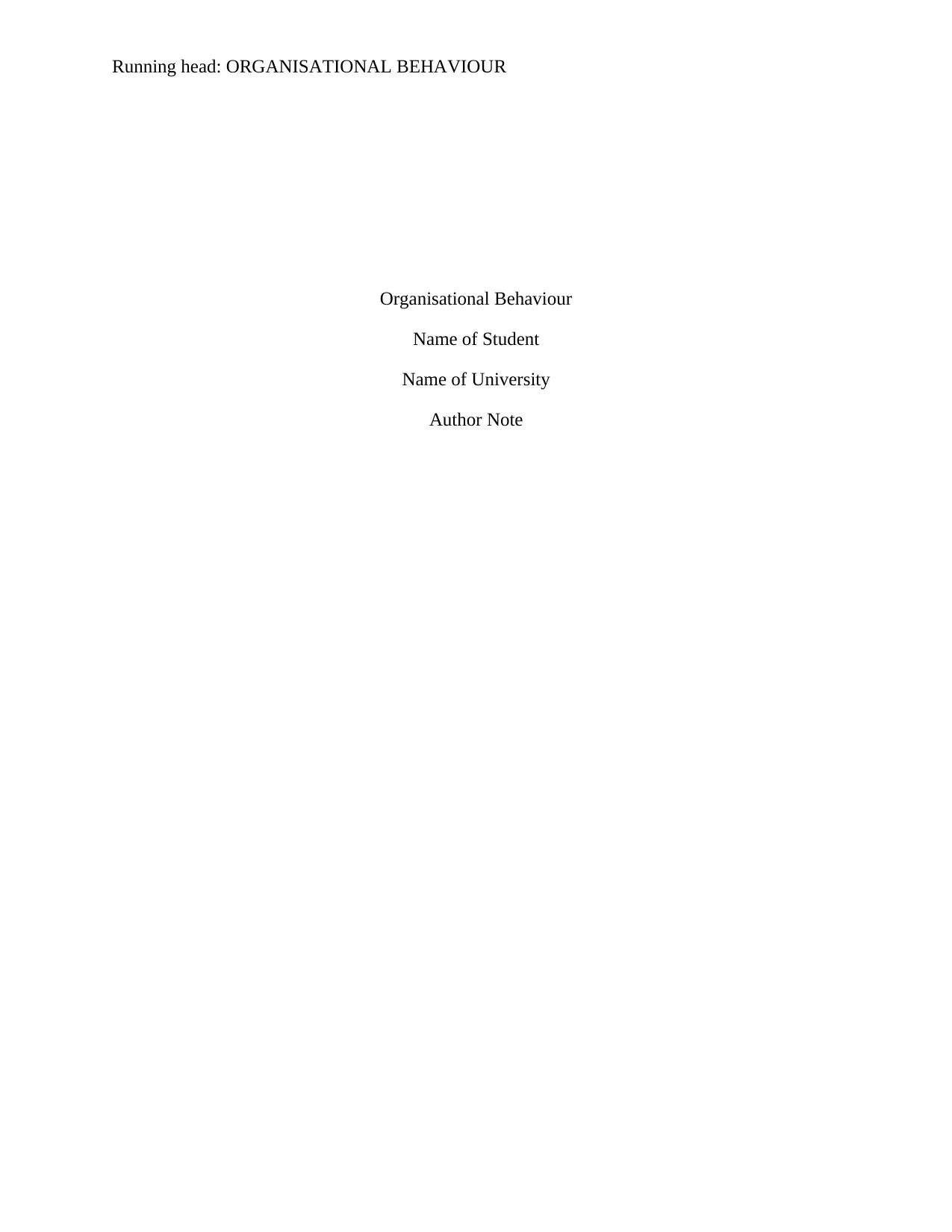
Running head: ORGANISATIONAL BEHAVIOUR
Organisational Behaviour
Name of Student
Name of University
Author Note
Organisational Behaviour
Name of Student
Name of University
Author Note
Paraphrase This Document
Need a fresh take? Get an instant paraphrase of this document with our AI Paraphraser
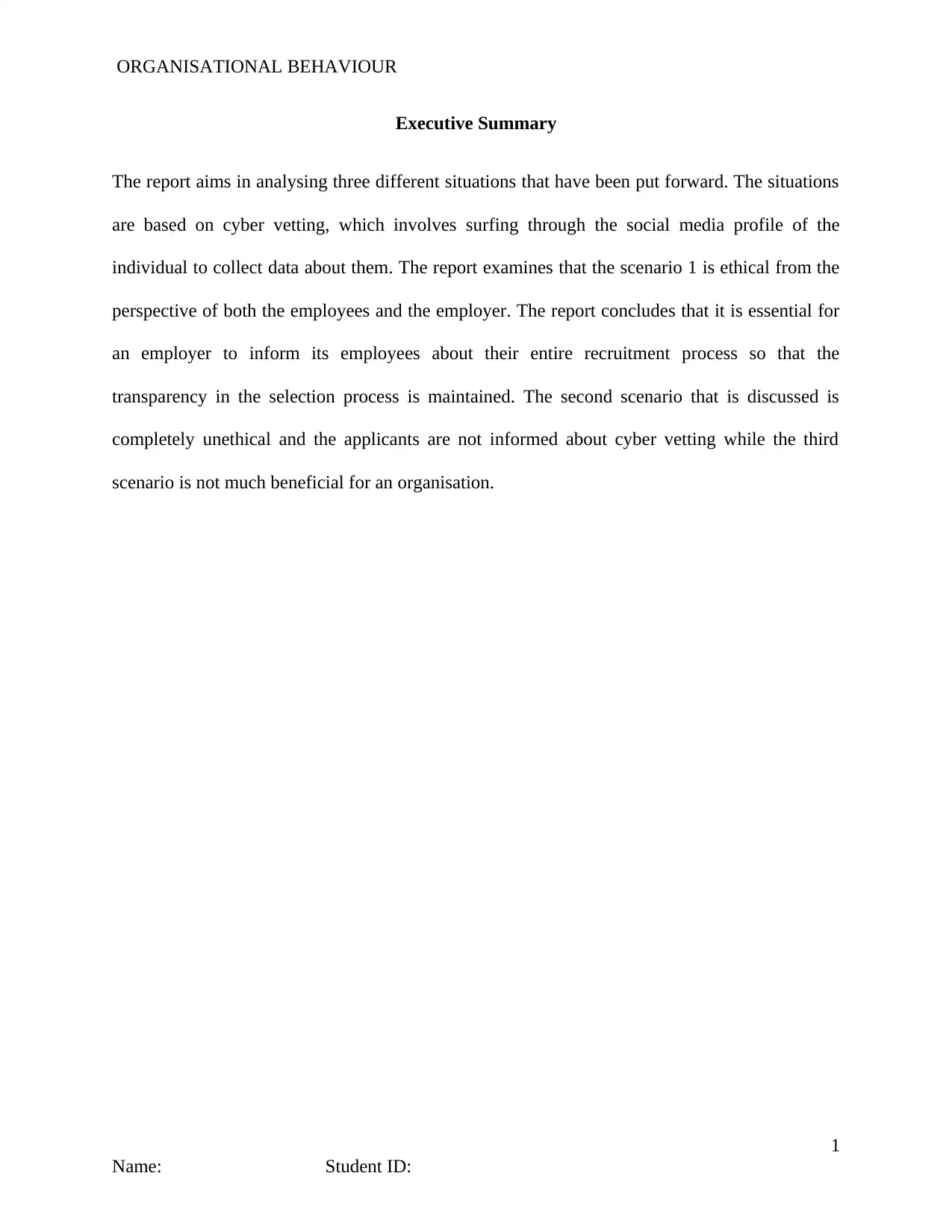
ORGANISATIONAL BEHAVIOUR
Executive Summary
The report aims in analysing three different situations that have been put forward. The situations
are based on cyber vetting, which involves surfing through the social media profile of the
individual to collect data about them. The report examines that the scenario 1 is ethical from the
perspective of both the employees and the employer. The report concludes that it is essential for
an employer to inform its employees about their entire recruitment process so that the
transparency in the selection process is maintained. The second scenario that is discussed is
completely unethical and the applicants are not informed about cyber vetting while the third
scenario is not much beneficial for an organisation.
1
Name: Student ID:
Executive Summary
The report aims in analysing three different situations that have been put forward. The situations
are based on cyber vetting, which involves surfing through the social media profile of the
individual to collect data about them. The report examines that the scenario 1 is ethical from the
perspective of both the employees and the employer. The report concludes that it is essential for
an employer to inform its employees about their entire recruitment process so that the
transparency in the selection process is maintained. The second scenario that is discussed is
completely unethical and the applicants are not informed about cyber vetting while the third
scenario is not much beneficial for an organisation.
1
Name: Student ID:
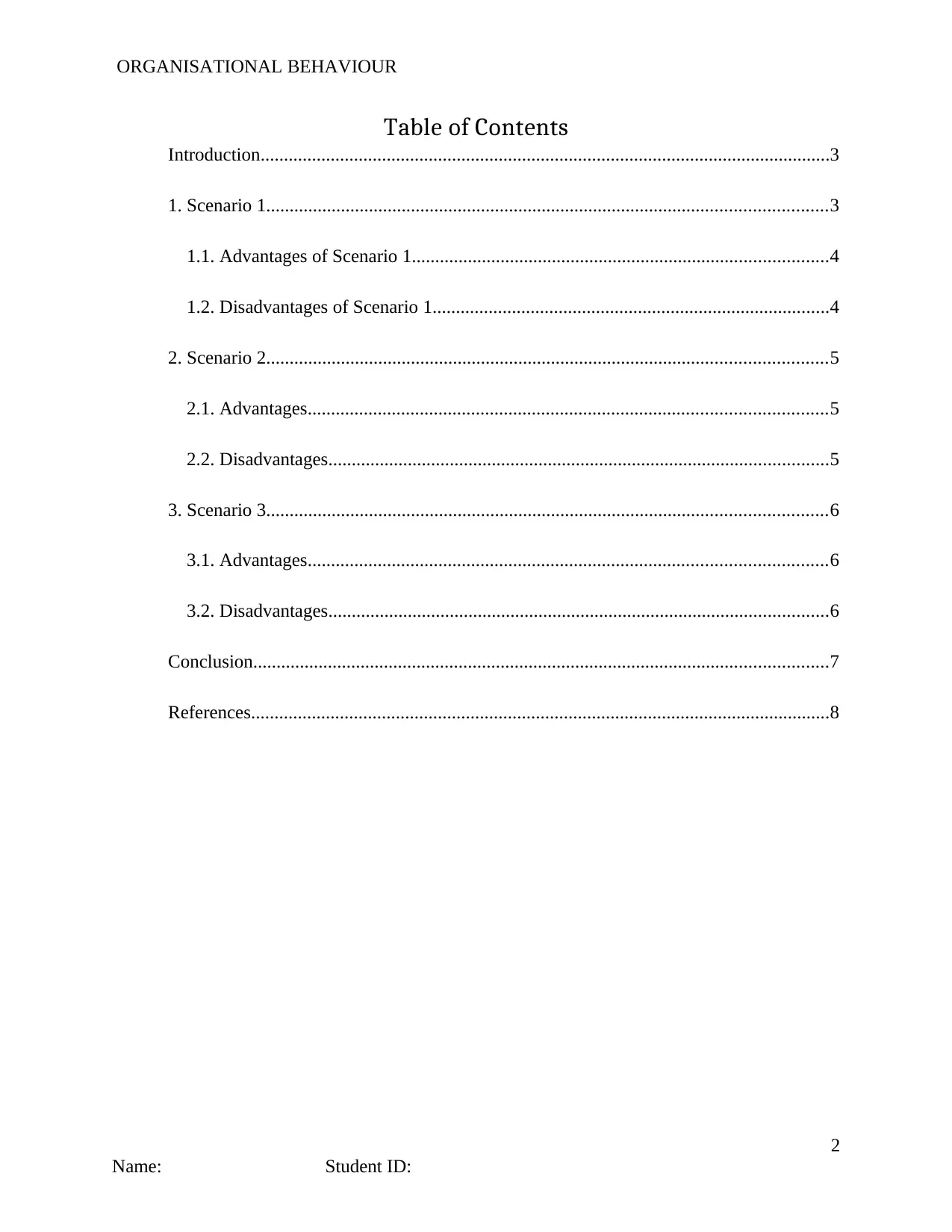
ORGANISATIONAL BEHAVIOUR
Table of Contents
Introduction..........................................................................................................................3
1. Scenario 1........................................................................................................................3
1.1. Advantages of Scenario 1.........................................................................................4
1.2. Disadvantages of Scenario 1.....................................................................................4
2. Scenario 2........................................................................................................................5
2.1. Advantages...............................................................................................................5
2.2. Disadvantages...........................................................................................................5
3. Scenario 3........................................................................................................................6
3.1. Advantages...............................................................................................................6
3.2. Disadvantages...........................................................................................................6
Conclusion...........................................................................................................................7
References............................................................................................................................8
2
Name: Student ID:
Table of Contents
Introduction..........................................................................................................................3
1. Scenario 1........................................................................................................................3
1.1. Advantages of Scenario 1.........................................................................................4
1.2. Disadvantages of Scenario 1.....................................................................................4
2. Scenario 2........................................................................................................................5
2.1. Advantages...............................................................................................................5
2.2. Disadvantages...........................................................................................................5
3. Scenario 3........................................................................................................................6
3.1. Advantages...............................................................................................................6
3.2. Disadvantages...........................................................................................................6
Conclusion...........................................................................................................................7
References............................................................................................................................8
2
Name: Student ID:
⊘ This is a preview!⊘
Do you want full access?
Subscribe today to unlock all pages.

Trusted by 1+ million students worldwide
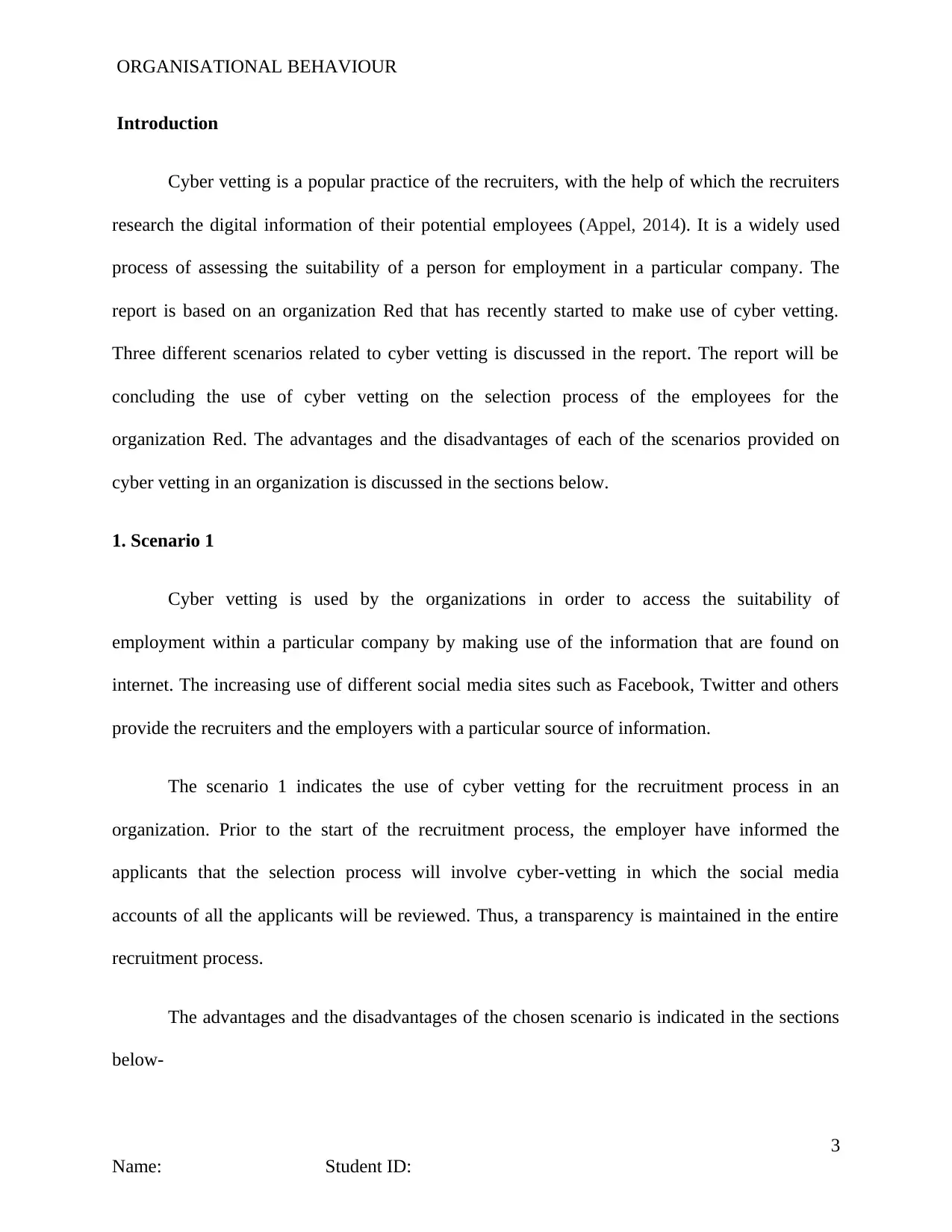
ORGANISATIONAL BEHAVIOUR
Introduction
Cyber vetting is a popular practice of the recruiters, with the help of which the recruiters
research the digital information of their potential employees (Appel, 2014). It is a widely used
process of assessing the suitability of a person for employment in a particular company. The
report is based on an organization Red that has recently started to make use of cyber vetting.
Three different scenarios related to cyber vetting is discussed in the report. The report will be
concluding the use of cyber vetting on the selection process of the employees for the
organization Red. The advantages and the disadvantages of each of the scenarios provided on
cyber vetting in an organization is discussed in the sections below.
1. Scenario 1
Cyber vetting is used by the organizations in order to access the suitability of
employment within a particular company by making use of the information that are found on
internet. The increasing use of different social media sites such as Facebook, Twitter and others
provide the recruiters and the employers with a particular source of information.
The scenario 1 indicates the use of cyber vetting for the recruitment process in an
organization. Prior to the start of the recruitment process, the employer have informed the
applicants that the selection process will involve cyber-vetting in which the social media
accounts of all the applicants will be reviewed. Thus, a transparency is maintained in the entire
recruitment process.
The advantages and the disadvantages of the chosen scenario is indicated in the sections
below-
3
Name: Student ID:
Introduction
Cyber vetting is a popular practice of the recruiters, with the help of which the recruiters
research the digital information of their potential employees (Appel, 2014). It is a widely used
process of assessing the suitability of a person for employment in a particular company. The
report is based on an organization Red that has recently started to make use of cyber vetting.
Three different scenarios related to cyber vetting is discussed in the report. The report will be
concluding the use of cyber vetting on the selection process of the employees for the
organization Red. The advantages and the disadvantages of each of the scenarios provided on
cyber vetting in an organization is discussed in the sections below.
1. Scenario 1
Cyber vetting is used by the organizations in order to access the suitability of
employment within a particular company by making use of the information that are found on
internet. The increasing use of different social media sites such as Facebook, Twitter and others
provide the recruiters and the employers with a particular source of information.
The scenario 1 indicates the use of cyber vetting for the recruitment process in an
organization. Prior to the start of the recruitment process, the employer have informed the
applicants that the selection process will involve cyber-vetting in which the social media
accounts of all the applicants will be reviewed. Thus, a transparency is maintained in the entire
recruitment process.
The advantages and the disadvantages of the chosen scenario is indicated in the sections
below-
3
Name: Student ID:
Paraphrase This Document
Need a fresh take? Get an instant paraphrase of this document with our AI Paraphraser
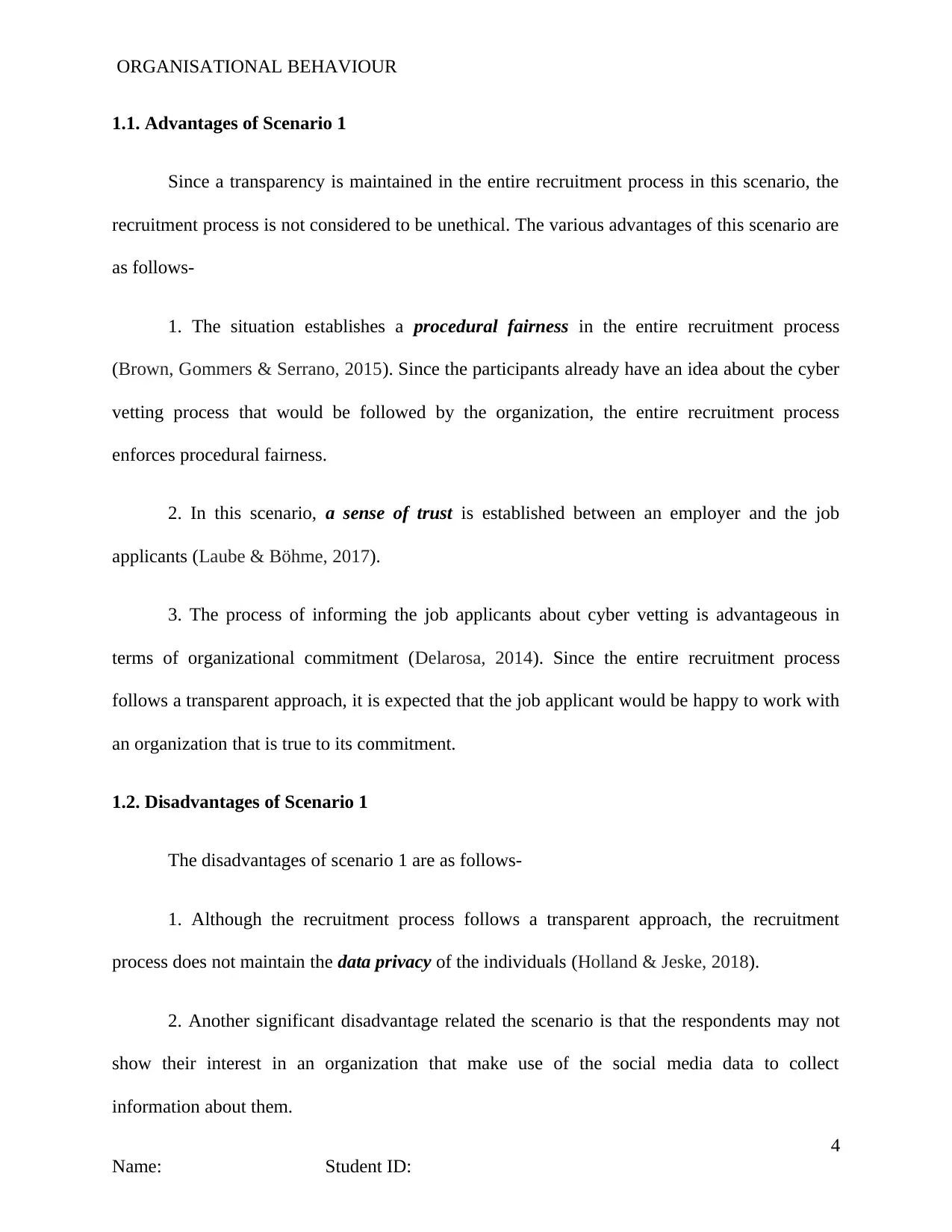
ORGANISATIONAL BEHAVIOUR
1.1. Advantages of Scenario 1
Since a transparency is maintained in the entire recruitment process in this scenario, the
recruitment process is not considered to be unethical. The various advantages of this scenario are
as follows-
1. The situation establishes a procedural fairness in the entire recruitment process
(Brown, Gommers & Serrano, 2015). Since the participants already have an idea about the cyber
vetting process that would be followed by the organization, the entire recruitment process
enforces procedural fairness.
2. In this scenario, a sense of trust is established between an employer and the job
applicants (Laube & Böhme, 2017).
3. The process of informing the job applicants about cyber vetting is advantageous in
terms of organizational commitment (Delarosa, 2014). Since the entire recruitment process
follows a transparent approach, it is expected that the job applicant would be happy to work with
an organization that is true to its commitment.
1.2. Disadvantages of Scenario 1
The disadvantages of scenario 1 are as follows-
1. Although the recruitment process follows a transparent approach, the recruitment
process does not maintain the data privacy of the individuals (Holland & Jeske, 2018).
2. Another significant disadvantage related the scenario is that the respondents may not
show their interest in an organization that make use of the social media data to collect
information about them.
4
Name: Student ID:
1.1. Advantages of Scenario 1
Since a transparency is maintained in the entire recruitment process in this scenario, the
recruitment process is not considered to be unethical. The various advantages of this scenario are
as follows-
1. The situation establishes a procedural fairness in the entire recruitment process
(Brown, Gommers & Serrano, 2015). Since the participants already have an idea about the cyber
vetting process that would be followed by the organization, the entire recruitment process
enforces procedural fairness.
2. In this scenario, a sense of trust is established between an employer and the job
applicants (Laube & Böhme, 2017).
3. The process of informing the job applicants about cyber vetting is advantageous in
terms of organizational commitment (Delarosa, 2014). Since the entire recruitment process
follows a transparent approach, it is expected that the job applicant would be happy to work with
an organization that is true to its commitment.
1.2. Disadvantages of Scenario 1
The disadvantages of scenario 1 are as follows-
1. Although the recruitment process follows a transparent approach, the recruitment
process does not maintain the data privacy of the individuals (Holland & Jeske, 2018).
2. Another significant disadvantage related the scenario is that the respondents may not
show their interest in an organization that make use of the social media data to collect
information about them.
4
Name: Student ID:
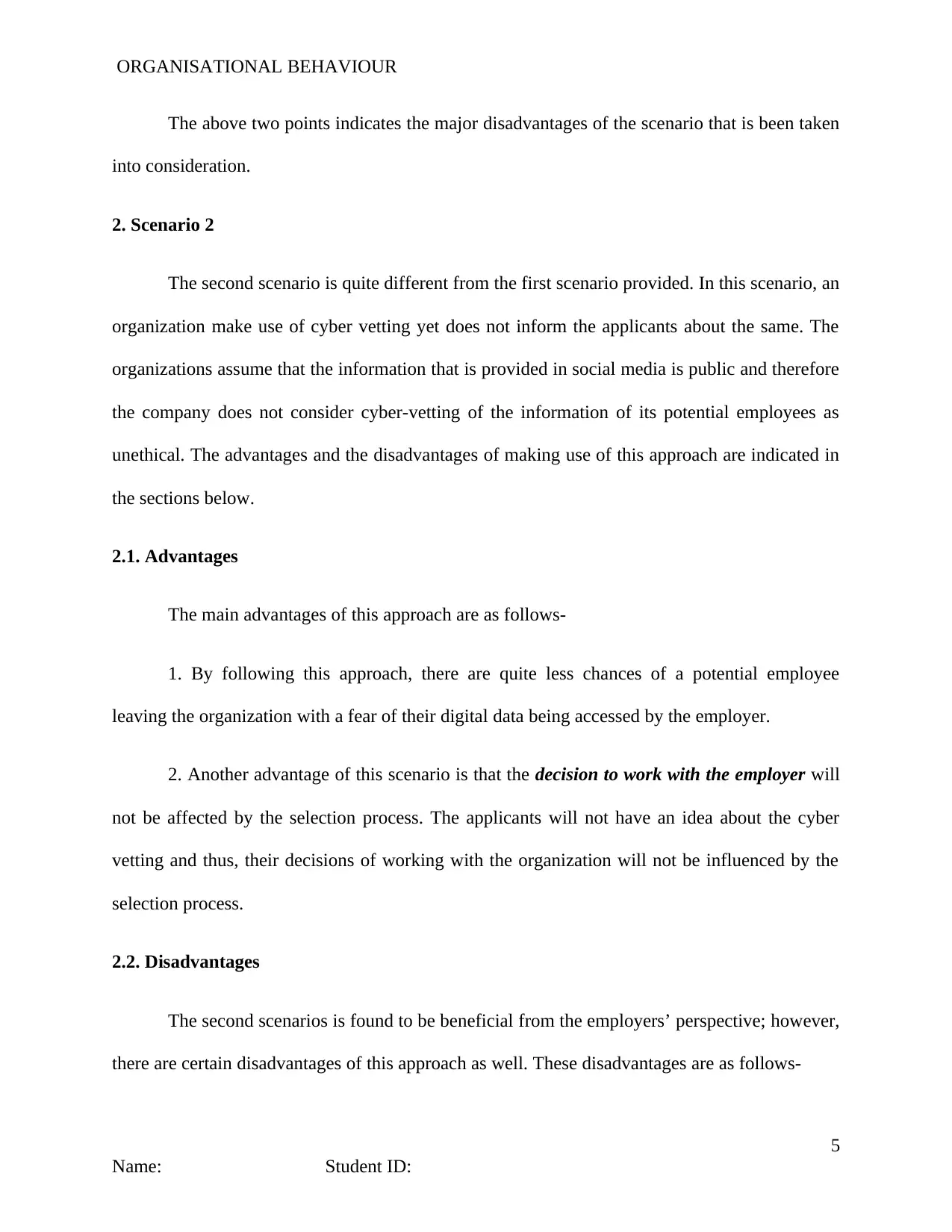
ORGANISATIONAL BEHAVIOUR
The above two points indicates the major disadvantages of the scenario that is been taken
into consideration.
2. Scenario 2
The second scenario is quite different from the first scenario provided. In this scenario, an
organization make use of cyber vetting yet does not inform the applicants about the same. The
organizations assume that the information that is provided in social media is public and therefore
the company does not consider cyber-vetting of the information of its potential employees as
unethical. The advantages and the disadvantages of making use of this approach are indicated in
the sections below.
2.1. Advantages
The main advantages of this approach are as follows-
1. By following this approach, there are quite less chances of a potential employee
leaving the organization with a fear of their digital data being accessed by the employer.
2. Another advantage of this scenario is that the decision to work with the employer will
not be affected by the selection process. The applicants will not have an idea about the cyber
vetting and thus, their decisions of working with the organization will not be influenced by the
selection process.
2.2. Disadvantages
The second scenarios is found to be beneficial from the employers’ perspective; however,
there are certain disadvantages of this approach as well. These disadvantages are as follows-
5
Name: Student ID:
The above two points indicates the major disadvantages of the scenario that is been taken
into consideration.
2. Scenario 2
The second scenario is quite different from the first scenario provided. In this scenario, an
organization make use of cyber vetting yet does not inform the applicants about the same. The
organizations assume that the information that is provided in social media is public and therefore
the company does not consider cyber-vetting of the information of its potential employees as
unethical. The advantages and the disadvantages of making use of this approach are indicated in
the sections below.
2.1. Advantages
The main advantages of this approach are as follows-
1. By following this approach, there are quite less chances of a potential employee
leaving the organization with a fear of their digital data being accessed by the employer.
2. Another advantage of this scenario is that the decision to work with the employer will
not be affected by the selection process. The applicants will not have an idea about the cyber
vetting and thus, their decisions of working with the organization will not be influenced by the
selection process.
2.2. Disadvantages
The second scenarios is found to be beneficial from the employers’ perspective; however,
there are certain disadvantages of this approach as well. These disadvantages are as follows-
5
Name: Student ID:
⊘ This is a preview!⊘
Do you want full access?
Subscribe today to unlock all pages.

Trusted by 1+ million students worldwide
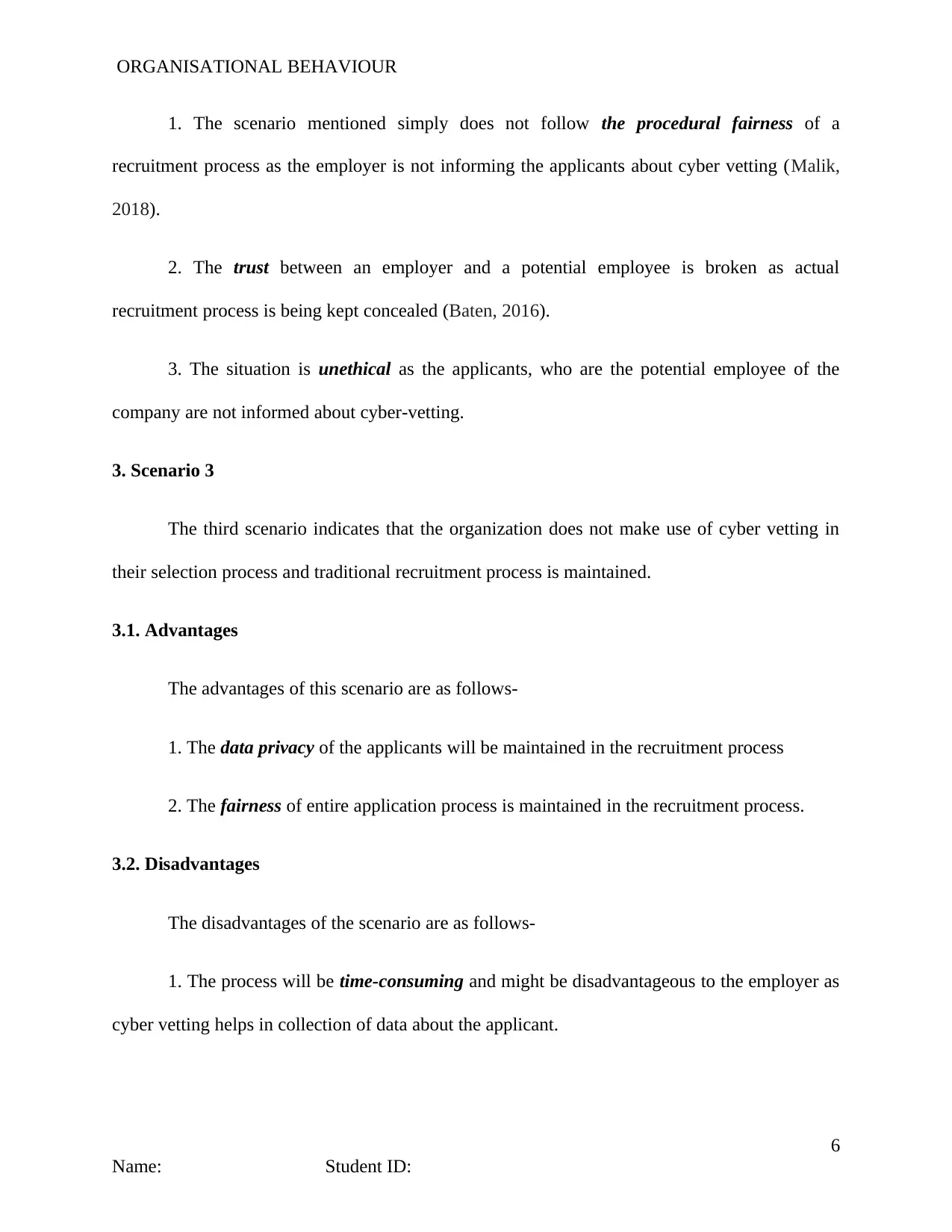
ORGANISATIONAL BEHAVIOUR
1. The scenario mentioned simply does not follow the procedural fairness of a
recruitment process as the employer is not informing the applicants about cyber vetting (Malik,
2018).
2. The trust between an employer and a potential employee is broken as actual
recruitment process is being kept concealed (Baten, 2016).
3. The situation is unethical as the applicants, who are the potential employee of the
company are not informed about cyber-vetting.
3. Scenario 3
The third scenario indicates that the organization does not make use of cyber vetting in
their selection process and traditional recruitment process is maintained.
3.1. Advantages
The advantages of this scenario are as follows-
1. The data privacy of the applicants will be maintained in the recruitment process
2. The fairness of entire application process is maintained in the recruitment process.
3.2. Disadvantages
The disadvantages of the scenario are as follows-
1. The process will be time-consuming and might be disadvantageous to the employer as
cyber vetting helps in collection of data about the applicant.
6
Name: Student ID:
1. The scenario mentioned simply does not follow the procedural fairness of a
recruitment process as the employer is not informing the applicants about cyber vetting (Malik,
2018).
2. The trust between an employer and a potential employee is broken as actual
recruitment process is being kept concealed (Baten, 2016).
3. The situation is unethical as the applicants, who are the potential employee of the
company are not informed about cyber-vetting.
3. Scenario 3
The third scenario indicates that the organization does not make use of cyber vetting in
their selection process and traditional recruitment process is maintained.
3.1. Advantages
The advantages of this scenario are as follows-
1. The data privacy of the applicants will be maintained in the recruitment process
2. The fairness of entire application process is maintained in the recruitment process.
3.2. Disadvantages
The disadvantages of the scenario are as follows-
1. The process will be time-consuming and might be disadvantageous to the employer as
cyber vetting helps in collection of data about the applicant.
6
Name: Student ID:
Paraphrase This Document
Need a fresh take? Get an instant paraphrase of this document with our AI Paraphraser
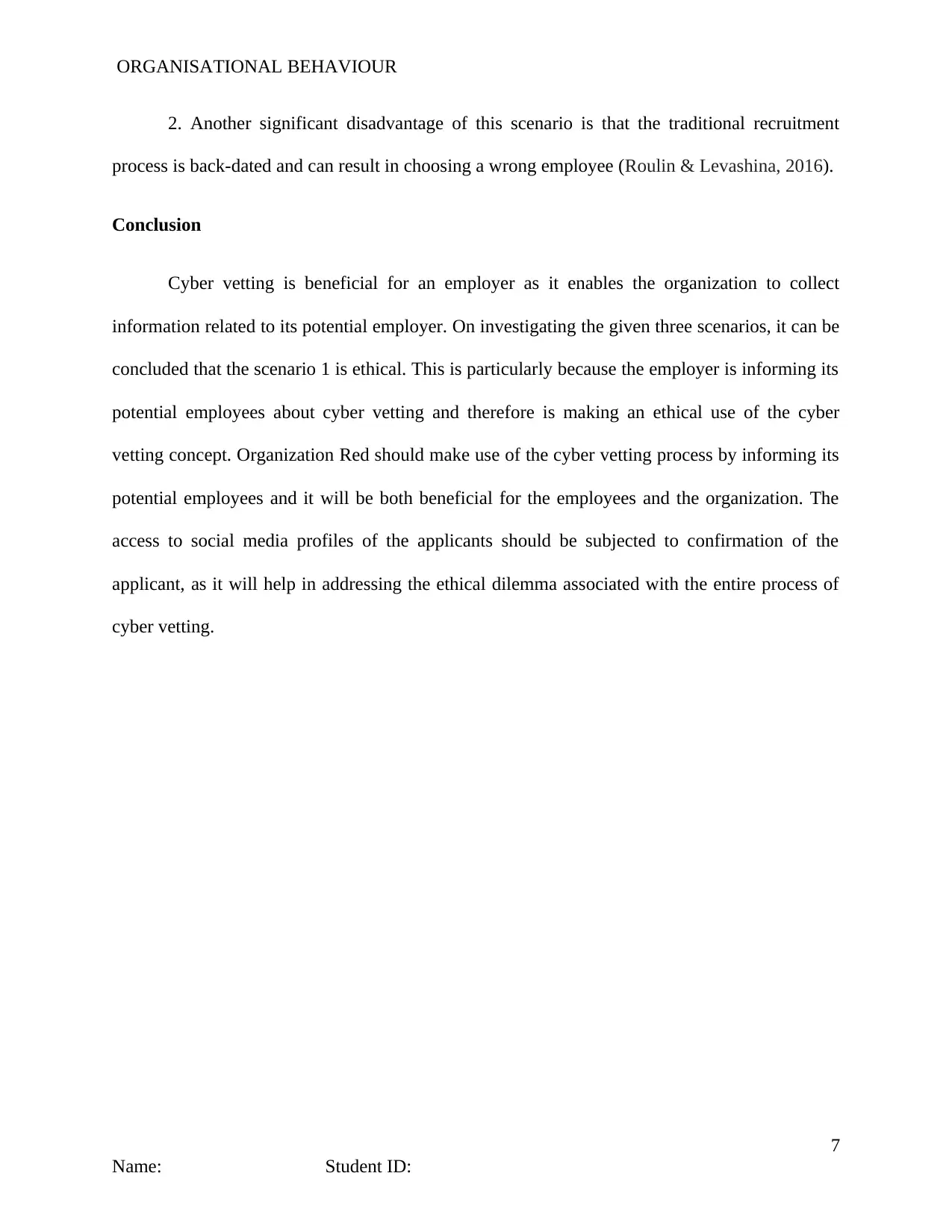
ORGANISATIONAL BEHAVIOUR
2. Another significant disadvantage of this scenario is that the traditional recruitment
process is back-dated and can result in choosing a wrong employee (Roulin & Levashina, 2016).
Conclusion
Cyber vetting is beneficial for an employer as it enables the organization to collect
information related to its potential employer. On investigating the given three scenarios, it can be
concluded that the scenario 1 is ethical. This is particularly because the employer is informing its
potential employees about cyber vetting and therefore is making an ethical use of the cyber
vetting concept. Organization Red should make use of the cyber vetting process by informing its
potential employees and it will be both beneficial for the employees and the organization. The
access to social media profiles of the applicants should be subjected to confirmation of the
applicant, as it will help in addressing the ethical dilemma associated with the entire process of
cyber vetting.
7
Name: Student ID:
2. Another significant disadvantage of this scenario is that the traditional recruitment
process is back-dated and can result in choosing a wrong employee (Roulin & Levashina, 2016).
Conclusion
Cyber vetting is beneficial for an employer as it enables the organization to collect
information related to its potential employer. On investigating the given three scenarios, it can be
concluded that the scenario 1 is ethical. This is particularly because the employer is informing its
potential employees about cyber vetting and therefore is making an ethical use of the cyber
vetting concept. Organization Red should make use of the cyber vetting process by informing its
potential employees and it will be both beneficial for the employees and the organization. The
access to social media profiles of the applicants should be subjected to confirmation of the
applicant, as it will help in addressing the ethical dilemma associated with the entire process of
cyber vetting.
7
Name: Student ID:
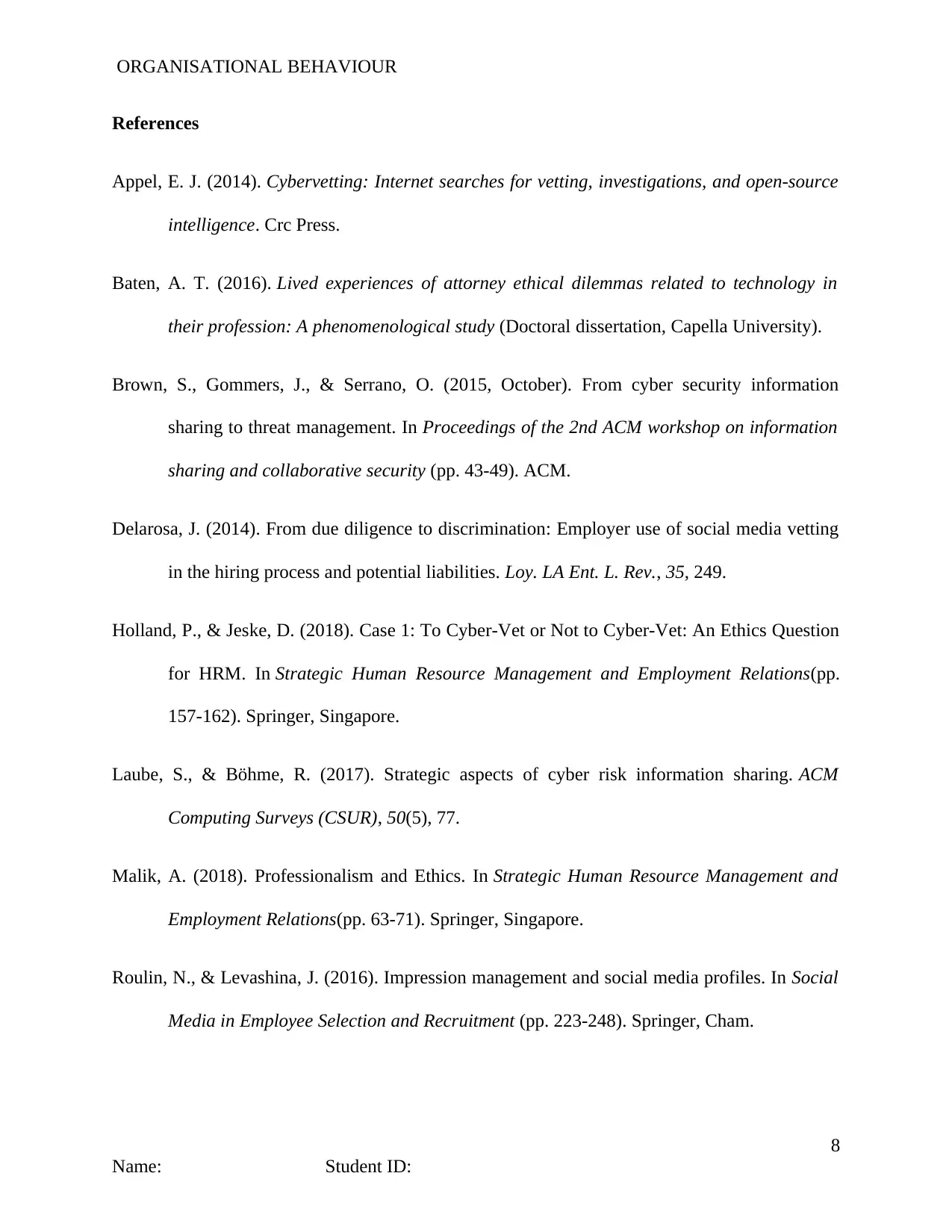
ORGANISATIONAL BEHAVIOUR
References
Appel, E. J. (2014). Cybervetting: Internet searches for vetting, investigations, and open-source
intelligence. Crc Press.
Baten, A. T. (2016). Lived experiences of attorney ethical dilemmas related to technology in
their profession: A phenomenological study (Doctoral dissertation, Capella University).
Brown, S., Gommers, J., & Serrano, O. (2015, October). From cyber security information
sharing to threat management. In Proceedings of the 2nd ACM workshop on information
sharing and collaborative security (pp. 43-49). ACM.
Delarosa, J. (2014). From due diligence to discrimination: Employer use of social media vetting
in the hiring process and potential liabilities. Loy. LA Ent. L. Rev., 35, 249.
Holland, P., & Jeske, D. (2018). Case 1: To Cyber-Vet or Not to Cyber-Vet: An Ethics Question
for HRM. In Strategic Human Resource Management and Employment Relations(pp.
157-162). Springer, Singapore.
Laube, S., & Böhme, R. (2017). Strategic aspects of cyber risk information sharing. ACM
Computing Surveys (CSUR), 50(5), 77.
Malik, A. (2018). Professionalism and Ethics. In Strategic Human Resource Management and
Employment Relations(pp. 63-71). Springer, Singapore.
Roulin, N., & Levashina, J. (2016). Impression management and social media profiles. In Social
Media in Employee Selection and Recruitment (pp. 223-248). Springer, Cham.
8
Name: Student ID:
References
Appel, E. J. (2014). Cybervetting: Internet searches for vetting, investigations, and open-source
intelligence. Crc Press.
Baten, A. T. (2016). Lived experiences of attorney ethical dilemmas related to technology in
their profession: A phenomenological study (Doctoral dissertation, Capella University).
Brown, S., Gommers, J., & Serrano, O. (2015, October). From cyber security information
sharing to threat management. In Proceedings of the 2nd ACM workshop on information
sharing and collaborative security (pp. 43-49). ACM.
Delarosa, J. (2014). From due diligence to discrimination: Employer use of social media vetting
in the hiring process and potential liabilities. Loy. LA Ent. L. Rev., 35, 249.
Holland, P., & Jeske, D. (2018). Case 1: To Cyber-Vet or Not to Cyber-Vet: An Ethics Question
for HRM. In Strategic Human Resource Management and Employment Relations(pp.
157-162). Springer, Singapore.
Laube, S., & Böhme, R. (2017). Strategic aspects of cyber risk information sharing. ACM
Computing Surveys (CSUR), 50(5), 77.
Malik, A. (2018). Professionalism and Ethics. In Strategic Human Resource Management and
Employment Relations(pp. 63-71). Springer, Singapore.
Roulin, N., & Levashina, J. (2016). Impression management and social media profiles. In Social
Media in Employee Selection and Recruitment (pp. 223-248). Springer, Cham.
8
Name: Student ID:
⊘ This is a preview!⊘
Do you want full access?
Subscribe today to unlock all pages.

Trusted by 1+ million students worldwide
1 out of 9
Related Documents
Your All-in-One AI-Powered Toolkit for Academic Success.
+13062052269
info@desklib.com
Available 24*7 on WhatsApp / Email
![[object Object]](/_next/static/media/star-bottom.7253800d.svg)
Unlock your academic potential
Copyright © 2020–2025 A2Z Services. All Rights Reserved. Developed and managed by ZUCOL.





